Abstract
Packing motifs within structurally characterized cis-[M(bpy)2X2] (M = any metal, bpy = 2,2′-bipyridine, X = F, Cl, Br, I) coordination compounds have been investigated using data from the Cambridge Structural Database. Compounds fall into two classes: non-solvated cis-[M(bpy)2X2] moieties and those with additional lattice molecules (solvent or other molecules). A recurring packing motif is a dimeric unit involving intermolecular face-to-face π-stacking of bpy ligands and CHbpy...X contacts, although in several cases, slippage of the stacked bpy units reduces the effectiveness of the face-to-face interaction leaving the CHbpy...X contacts as the dominant crystal-packing interaction. The prevalence of the dimeric unit versus the assembly of 1D-chains in the solid state is described.
1. Introduction
The structural information in the Cambridge Structural Database [1] allows the detailed analysis of structural patterns at the molecular level, as well as in terms of crystal packing. We have recently drawn attention to a dominant crystal-packing motif in the solid-state structures of [M(bpy)3]q+ salts (bpy = 2,2′-bipyridine) containing halide anions, in which six homochiral [M(bpy)3]q+ cations embrace a halide anion (Figure 1a) [2]. We subsequently extended this investigation to [M(bpy)3]q+ salts containing [XY3]m– and [XY4]m– anions, and demonstrated that four packing motifs dominate, the most common of which involve a hexagonal arrangement of six cations with anions either in the center or lying above and/or below the centroid of the hexagon (Figure 1b) [3]. Homochiral layers of [M(bpy)3]q+ cations are common in the crystal packing of these structures. In these first two studies, we showed that short contacts between an anion and atoms H3 and H3′ of the bpy ligands (see Scheme 1 for numbering) are often supplemented by contacts with H4 and H5. This leads to a more general theme in the supramolecular chemistry of crystals containing [M(bpy)3]q+ cations [3]. The chirality of the [M(bpy)3]q+ cation is fundamental to the packing interactions that we have described [2,3], and we decided, therefore, to extend the structural investigations to neutral cis-[M(bpy)2X2] compounds in which X = F, Cl, Br, and I. The presence of intermolecular face-to-face π-stacking interactions between bpy domains has been noted by a number of authors [4,5,6,7,8,9,10,11,12,13,14,15], and Kruszynski and coworker recognized the interactions depicted in Scheme 2 in [Cd(bpy)2F2]·3.5H2O and [Cd(bpy)2I2], respectively [6]. Intermolecular CHbpy...X contacts in cis-[M(bpy)2X2] complexes have also been described [7,10,16,17,18]. However, the recurrence of particular packing motifs within the wide range of structurally characterized cis-[M(bpy)2X2] species and the relationship between them has not, to the best of our knowledge, been addressed.
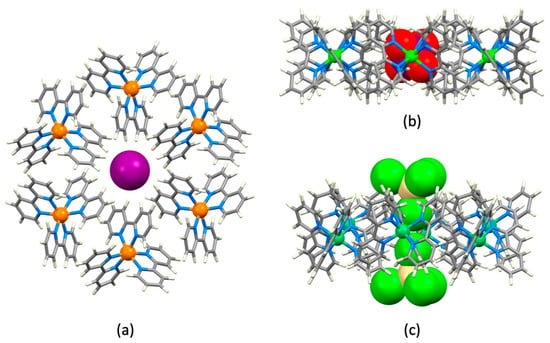
Figure 1.
Hexagonal motifs in (a) [Li(bpy)3]I·bpy (CSD refcode REXVOF) [19], (b) [Zn(bpy)3][CrO4]0.5[NO3]·6.5H2O (refcode XUJDEL) [20], and (c) [Ni(bpy)3][CdCl4] (refcode BINZON) [21]. Color code: C, gray; H, off-white; N, blue; I, purple; Cl, green; O, red.
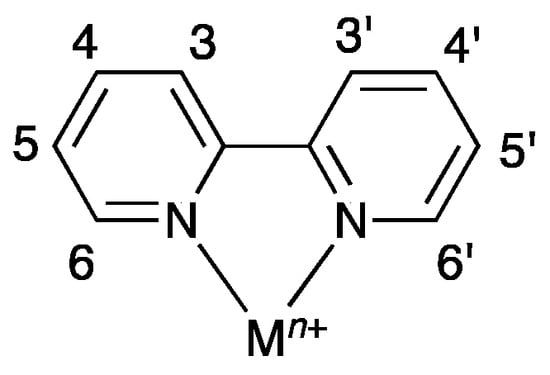
Scheme 1.
Hydrogen atom numbering in 2,2′-bipyridine; the conformation adopted by the metal-coordinated chelating ligand is shown.

Scheme 2.
Two bpy...bpy stacking interactions described by Kruszynski in [Cd(bpy)2F2]·3.5H2O and [Cd(bpy)2I2], respectively [6].
2. Methods
Conquest (version 2022.3.0 including November 2022 updates) [22] was used to search the CSD [1] for the [M(bpy)2X2] unit (M = any metal; X = halogen) and neutral compounds were selected from the hits that included both neutral and cationic species. Substituted bpy ligands were excluded by explicitly entering C-bonded H atoms. The connectivity of M was restricted to six, and no restriction was placed on the isomer (cis or trans). The connectivity of each X atom was constrained to one, and M–X bonds, as well as the inter-ring C–C bond in bpy, were set to ‘any type’. Polymeric structures were excluded.
Analysis of structures was carried out using Mercury (version 2022.3.0) [23]. In some structures, H atom coordinates were not available, and in this case, the H positions were added in Mercury [23]. All H positions were normalized within Mercury, such that all C–H bond lengths were 1.089 Å. The settings in Mercury for a ‘short contact’ (sum of the van der Waals radii + 0.1 Å) were applied to locate H...X interactions, as well as cation...anion contacts. Disordered structures were retained in the analysis.
3. Initial Search Results and Selection of Structures for Detailed Analysis
An initial search of the CSD (version 2.22.3.0) [22] for the [M(bpy)2X2] unit gave 86 hits. Of these, two were trans-isomers (CSD refcodes HIQPIH and NEZTEU). Of interest here is the fact that trans-[Ru(bpy)2Br2]Br (refcode NEZTEU [24]) contains motifs comprising a bromide ion surrounded by four trans-[Ru(bpy)2Br2]+ cations with short H3 and H3′ to Br− contacts from two bpy ligands supplemented by contacts to H5 and H6 of two other bpy ligands (Figure 2 and Table 1). This packing motif was not discussed in the original work [24], and is complementary to the halide-embraces that we described for halide salts of [M(bpy)3]q+ (Figure 1a) [2]. Figure 2 illustrates the bromide embrace in trans-[Ru(bpy)2Br2]Br and also shows that this motif is supported by additional CHbpy...Br–Ru interactions involving bpy atoms H4 and H4′ (CHbpy...Br distances = 2.697 and 2.738 Å, Cbpy...Br = 3.626(6) and 3.664(5) Å, ∠C–H...Br = 142.7 and 142.9°).
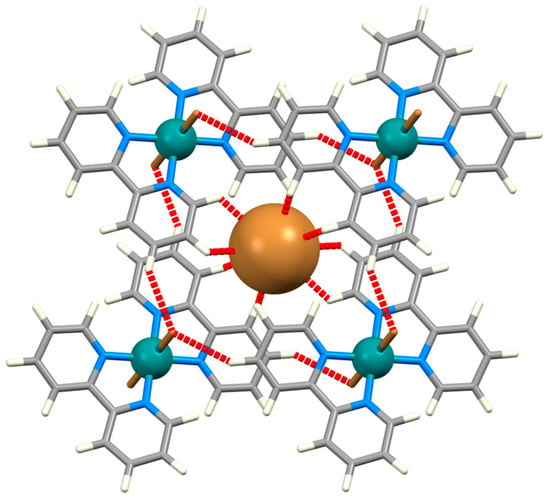
Figure 2.
Bromide embrace motif in trans-[Ru(bpy)2Br2]Br (refcode NEZTEU) [24] showing eight H3...Br−, H3′...Br−, H5...Br−, and H6...Br− contacts and eight RuBr...H4 and RuBr...H4′ interactions.

Table 1.
Parameters for CHbpy...Br− ion contacts in trans-[Ru(bpy)2Br2]Br.
For five structures in the initial search, atom coordinates were unavailable (refcodes QQQEQD, QQQEQG, QQQEQJ, QQQEQM, and QQQEQP). The structures with CSD refcodes YEYJAQ, YEYLIA, YEYLAS, YEYJUK, YEYKEV, YEYKAR, YEYKUL, ESIXOU, and ESILOH contained additional molecular species, which significantly impacted the crystal packing. These were excluded from the detailed analysis. This left 70 structures (including several redeterminations) that fell into the classes of non-solvated cis-[M(bpy)2X2], cis-[M(bpy)2X2] with lattice molecules (solvent or other molecules), and salts of cis-[M(bpy)2X2]q+. In this paper, we focus only on the neutral cis-[M(bpy)2X2] compounds. We note that data for Kruszynski’s structural determination of [Cd(bpy)2I2] mentioned in the introduction [6] are not available in the CSD. However, this polymorph is isostructural with the entry TIBLAT and so is included in our analysis.
4. Non-Solvated cis-[M(bpy)2X2] Compounds
Non-solvated cis-[M(bpy)2X2] complexes fall into several structural groups, but typically they exhibit a common packing motif. Compounds in the first group (Table 2) crystallize in the monoclinic space group P21/c; the two bpy ligands are crystallographically independent, as are the two halido ligands. The packing motifs in the first group are centrosymmetric dimers associated through face-to-face π-stacking of pyridine rings and CH...X contacts. The two independent bpy ligands are labelled A and B in Figure 3, and the two dimeric motifs are shown in Figure 3a, 3b, and 3c, respectively. The dimeric motif involving a bpyA...bpyA π-stacking interaction involves both pyridine rings (Figure 3a,b), whereas the bpyB...bpyB π-stacking contact is offset such that only one pyridine ring of each bpy is involved (Figure 3c). Centroid...centroid distances are given in Table 2 and are consistent with the ranges quoted by Janiak [25]. Each stacking interaction is supported by weak CH...X contacts involving H3 (Figure 3a,b) or H4 (Figure 3c), and metric parameters for the interactions are given in Table 2. The two motifs combine to generate 1D-chains as shown in Figure 3d, and the chains are interconnected by additional CH...Br interactions involving bpy H4 and H5 atoms. The data in Table 2 illustrate that on going from X = Cl to Br to I, the centroid...centroid distances for the π-stacking interactions increase, leading to a decrease in the efficiency of the interactions. This is especially noticeable in cis-[Mn(bpy)2I2] (CSD refcode ISAFOY [26]). However, it is noteworthy that the packing motif persists despite the reduced effectiveness of the face-to-face π-stacking. Significantly, one polymorph of cis-[Cd(bpy)2I2] (CSD refcode TIBLAT [27]) crystallizes in the orthorhombic space group Pbcn with half a molecule in the asymmetric unit; all bpy ligands (and all iodido ligands) are, therefore, crystallographically equivalent. Figure 4a and Table 3 demonstrate that efficient face-to-face π-stacking is restored and, again, the interaction is augmented by CH...X contacts involving H3 and H4. The unit is repeated along the crystallographic c-axis, giving 1D-chains (Figure 4b). The iodido complex cis-[Ca(bpy)2I2] (CSD refcode TAQQET [28]) adopts the same structure (Table 3).
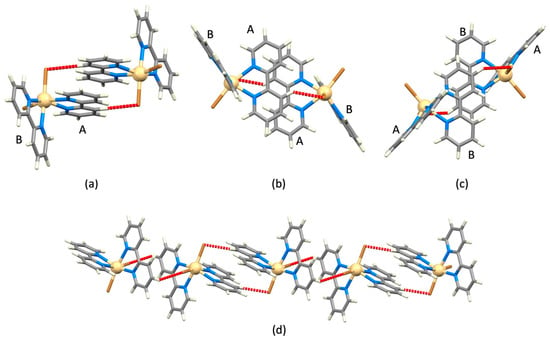
Figure 3.
Primary packing motifs in the first group of non-solvated cis-[M(bpy)2X2] illustrated with the structure of cis-[Cd(bpy)2Br2] (CSD refcode DEYQUU01 [31]). (a,b) Two views of the centrosymmetric bpyA...bpyA π-stacking interaction with H3...Br contacts (in red), (c) the centrosymmetric bpyB...bpyB π-stacking interaction with H3...Br contacts (in red), and (d) heterochiral 1D-chains resulting from a combination of the two motifs.

Figure 4.
Packing interactions in cis-[Cd(bpy)2I2] (CSD refcode TIBLAT [27]): (a) π-stacking interaction with H3...I and H4...I contacts (in red), and (b) assembly of a 1D-chain.

Table 3.
Metric parameters for the face-to-face π-stacking and CH...X contacts in the packing motif in cis-[M(bpy)2I2] (M = Cd, Ca). See Figure 4a.

Table 2.
Metric parameters for the face-to-face π-stacking and CH...X contacts in the centrosymmetric dimeric motifs in the first group of non-solvated cis-[M(bpy)2X2].
Table 2.
Metric parameters for the face-to-face π-stacking and CH...X contacts in the centrosymmetric dimeric motifs in the first group of non-solvated cis-[M(bpy)2X2].
| REFCODE Space Group | M | X | Centroid...Centroid (Figure 3a,b)/Å | Centroid...Centroid (Figure 3c)/Å | CH...X, C...X (Figure 3a,b)/Å | ∠C–H...X (Figure 3a,b)/° | CH...X, C...X (Figure 3c)/Å | ∠C–H...X (Figure 3c)/° | Ref |
|---|---|---|---|---|---|---|---|---|---|
| GALMAH P21/c | Mn | Cl | 3.92 | 3.66 | 2.705, 3.639(5) | 143.5 | 2.669, 3.650(5) | 149.7 | [16] |
| GALMAH01 P21/c | Mn | Cl | 3.85 | 3.64 | 2.630, 3.587(3) | 146.4 | 2.670, 3.618(3) | 145.1 | [18] |
| IRUBAB P21/c | Co | Cl | 3.93 | 3.64 | 2.660, 3.648(2) | 150.5 | 2.662, 3.619(2) | 146.3 | [29] |
| WABWAZ P21/c | Cd | Cl | 3.91 | 3.70 | 2.699, 3.635(7) | 143.8 | 2.700, 3.654(7) | 146.0 | [30] |
| DEYQUU01 P21/c | Cd | Br | 4.06 | 3.84 | 2.814, 3.710(6) | 139.5 | 2.826, 3.748(6) | 142.4 | [31] |
| TIRCON P21/c | Mn | Br | 4.07 | 3.76 | 2.746, 3.673(3) | 142.8 | 2.760, 3.692(3) | 143.5 | [8] |
| TIRCON02 P21/c | Mn | Br | 4.05 | 3.75 | 2.713, 3.630(2) | 141.6 | 2.758, 3.655(2) | 139.6 | [32] |
| UPUTIJ P21/c | Co | Br | 4.14 | 3.77 | 2.751, 3.718(6) | 147.8 | 2.751, 3.700(6) | 145.4 | [33] |
| UPUTIJ01 P21/c | Co | Br | 4.07 | 3.75 | 2.704, 3.664(3) | 146.7 | 2.731, 3.648(3) | 141.7 | [34] |
| ISAFOY P21/c | Mn | I | 4.39 | 4.06 | 2.966, 3.820(6) | 135.5 | 2.985, 3.848(6) | 136.4 | [26] |
We noted earlier that the structure of cis-[Mn(bpy)2I2] (CSD refcode ISAFOY [26], Table 2) exhibits non-optimal face-to-face π-stacking. It is, therefore, significant that a second polymorph (CSD refcode ISAFOY01 [14]) has been reported, and that this is structurally analogous to cis-[Cd(bpy)2I2] (CSD refcode ABEBIV [35], a polymorph of the compound with CSD refcode TIBLAT, Figure 4). These polymorphs of cis-[Mn(bpy)2I2] and cis-[Cd(bpy)2I2] crystallize in the monoclinic space group C2/c and exhibit a packing motif reminiscent of that shown in Figure 3c. However, whereas the latter is centrosymmetric, that shown in Figure 5a contains stacked bpy units that are related by a glide plane. Parameters for the face-to-face π-stacking and CH...X contacts in this motif are given in Table 4. Since each motif contains two crystallographically independent bpy ligands, all bpy...bpy stacking interactions within the structure are equivalent; the motifs pack into heterochiral sheets (Figure 5b) supported by the interactions detailed in Table 4 and additional CH...I contacts.
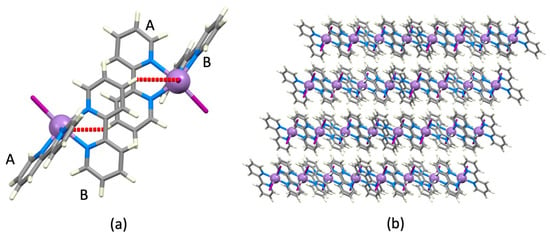
Figure 5.
Packing interactions in cis-[Mn(bpy)2I2] (CSD refcode ISAFOY01 [14]): (a) the basic motif contains a π-stacking interaction and H4...I contacts (in red), and (b) assembly of heterochiral layers. The crystallographically independent bpy ligands are labelled A and B.

Table 4.
Metric parameters for the face-to-face π-stacking and CH...X contacts in the motif in cis-[M(bpy)2I2] (M = Mn, Cd). See Figure 5a.
A second polymorph of each of cis-[Mn(bpy)2Br2] (CSD refcodes TIRCON/TIRCON02 in Table 2 and TIRCON01 in Table 5) and cis-[Cd(bpy)2Br2] (CSD refcode DEYQUU01 in Table 2, and DEYQUU and TIBLIB in Table 5) has also been structurally characterized and this structure type represents an alternative packing of non-solvated cis-[M(bpy)2Br2] molecules (Table 5) in which bpy...bpy π-stacking is absent. The dominant crystal-packing interactions involve H3...Br and H5...Br contacts (Table 5). To allow a comparison with the first group of cis-[Mn(bpy)2Br2] compounds described above, the packing motifs in the second group are best considered as shown in Figure 6. A centrosymmetric motif involving H5...Br contacts (Figure 6a,b) is related to that shown in Figure 3c. However, the motif in Figure 6b is slipped with respect to that in Figure 3c. This is a consequence of a change from an H4...Br to H5...Br interaction and it results in loss of an effective bpy...bpy π-stacking interaction; in cis-[Mn(bpy)2Br2] (Figure 6b), the distance between the centroids of the central two pyridine rings is 4.47 Å, which is at the upper limit considered by Janiak [25]. Additional H5...Br contacts link the motifs into heterochiral 1D-chains (Figure 6c), and these are interconnected through H3...Br and CH...π interactions [36] (Figure 6d).

Table 5.
Metric parameters for CH...X contacts in the group of non-solvated cis-[M(bpy)2X2] (Figure 6). H3 and H5 in the columns headings refer to bpy H atoms.
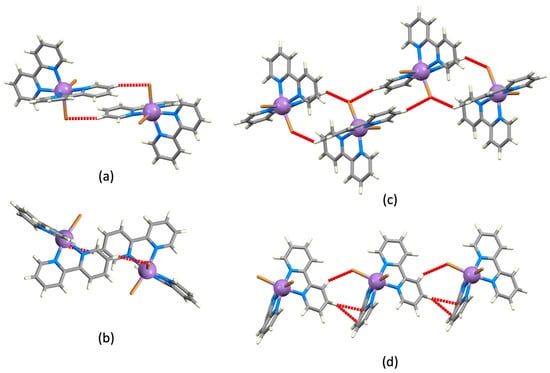
Figure 6.
(a,b) Two views of the centrosymmetric motif in cis-[Mn(bpy)2Br2] (CSD refcode TIRCON01 [37]) involving H5...Br contacts, and (c) propagation of chains supported by H5...Br contacts. (d) Chains are interconnected through H3...Br and CH...π interactions.
5. cis-[M(bpy)2X2] Compounds with Lattice Molecules
The analysis in Section 4 of the crystal structures of non-solvated cis-[M(bpy)2X2] complexes with X = Cl, Br, and I demonstrates the dominance of a dimeric motif featuring a bpy...bpy π-stacking interaction augmented by CHbpy...X interactions (Hbpy = H3, H4 or H5). In only a few cases was this motif absent. We now move from non-solvated cis-[M(bpy)2X2] to structures containing solvent or other molecules in the crystal lattice starting with hydrates. The compounds cis-[Co(bpy)2Cl2]·2H2O (CSD refcode NAPBIT) [39], cis-[Co(bpy)2Cl2]·3H2O (CSD refcode UNOJEN) [40], cis-[Mn(bpy)2Cl2]·2H2O·EtOH (CSD refcode SASQAE) [5], cis-[Ni(bpy)2Cl2]·2H2O·0.5MeCN (CSD refcode CEFHIE) [13], and cis-[Ru(bpy)2Cl2]·3.5H2O (CSD refcode DOGMOB [4]) crystallize in the monoclinic space group C2/c with half of one [M(bpy)2X2] unit in the asymmetric unit. The centrosymmetric motif shown in Figure 7a is common to these structures (Table 6) and the CHbpy...X interactions involve H3 and H3′. Extension of the interactions depicted in Figure 7a leads to the assembly of 1D-chains (Figure 7b). Note the relationship between this structure and that shown for one polymorph of cis-[Cd(bpy)2I2] (Figure 4b).

Figure 7.
Packing interactions in cis-[Co(bpy)2Cl2] (CSD refcode NAPBIT [39]): (a) centrosymmetric π-stacking interaction between bpy ligands with supporting H3...Cl and H3′...Cl contacts (in red), and (b) assembly of a 1D-chain.

Table 6.
Metric parameters for the bpy...bpy π-stacking and CHbpy...X interactions in cis-[Co(bpy)2Cl2]·2H2O (see Figure 7) and related compounds.
The lower part of Table 6 (from refcode OCERUK onwards) gives structural data for other solvates of cis-[M(bpy)2X2] as well as cis-[Ru(bpy)2Cl2]·1.7I2, which exhibit the packing motif shown in Figure 7a. Although Nag et al. [42] commented that the unit cell volume increases from 2245(5) Å3 to 2594(5) Å3 upon going from cis-[Ru(bpy)2Cl2]·3.5H2O (CSD refcode DOGMOB [4]) to cis-[Ru(bpy)2Cl2]·1.7I2 (CSD refcode OCERUK [42]), they did not note the similarity of the packing motifs. As in cis-[Ru(bpy)2Cl2]·3.5H2O, the [Ru(bpy)2Cl2] molecules in cis-[Ru(bpy)2Cl2]·1.7I2 assemble into chains (analogous to that in Figure 7b) with bpy...bpy π-stacking and CHbpy...X interactions involving H3 (Table 6). The parameters in Table 6 and the overlaid structures in Figure 8 illustrate the greater offset of the bpy...bpy π-stacking interaction in cis-[Ru(bpy)2Cl2]·1.7I2 (red in Figure 8) versus cis-[Ru(bpy)2Cl2]·3.5H2O (blue in Figure 8). Nonetheless, the motifs are essentially the same, and 1D-chains similar to that shown in Figure 7b are observed in both compounds. Similar motifs and 1D-chain assembly are found in cis-[Ni(bpy)2Br2]·2DMF (DMF = N,N-dimethylformamide, CSD refcode NIGTEF [44]) except, here, the bpy ligands are crystallographically independent, giving rise to two distinct bpy...bpy π-stacking motifs (Table 6). The same is true in cis-[Mn(bpy)2Cl2]·0.5bpy·2.5H2O (CSD refcode XURZOZ [11]) (Table 6) and it is interesting to note that the presence of the free bpy molecules does not disrupt the assembly of packing domains. The compounds cis-[Ni(bpy)2Cl2]·MeOH (CSD refcode ABUWAV [48]) and [Os(bpy)2Cl2]·MeOH (CSD refcode CIBJIJ [49]) also exhibit centrosymmetric dimeric motifs similar to that in Figure 7a (Table 6), but hydrogen bonding between the chlorido ligands and MeOH significantly affects the extended packing. In contrast, the introduction of thiourea molecules into the crystal lattice of cis-[Mn(bpy)2Cl2]·SC(NH2)2 (CSD refcode ADEVIP) has a significant influence, as detailed by Choudhury et al. [12]. The centrosymmetric dimeric unit found in [Mn(bpy)2Cl2]·SC(NH2)2 (Figure 9) bears a resemblance to motifs described earlier. It involves bpy H4...Cl contacts (Figure 9) and face-to-face π-stacking between only two pyridine rings (centroid...centroid = 3.76 Å), and closely resembles the motif displayed in Figure 5a.
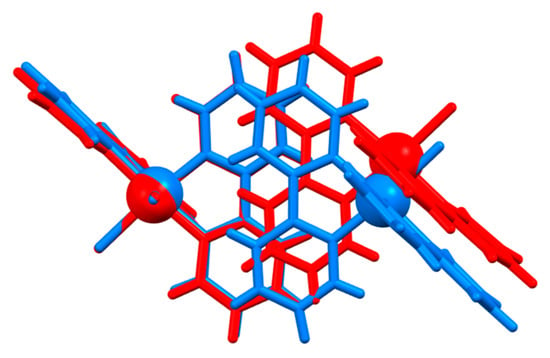
Figure 8.
Overlay of the dimeric units in cis-[Ru(bpy)2Cl2]·3.5H2O (CSD refcode DOGMOB [4]) shown in blue and in cis-[Ru(bpy)2Cl2]·1.7I2 (CSD refcode OCERUK [42]) displayed in red. The molecules on the left are overlaid using pairs of Ru and Cl atoms in Mercury [23]. This reveals the greater offset nature of the bpy...bpy π-stacking interaction in cis-[Ru(bpy)2Cl2]·1.7I2 (red) versus cis-[Ru(bpy)2Cl2]·3.5H2O (blue).
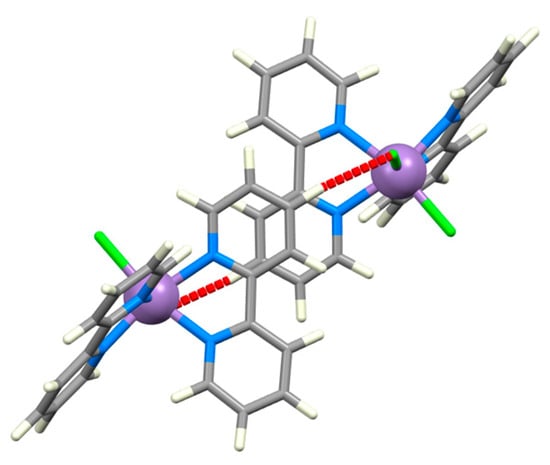
Figure 9.
Centrosymmetric packing motif in [Mn(bpy)2Cl2]·SC(NH2)2 (CSD refcode ADEVIP) [12]. The H4...Cl contacts are shown in red (CH4...Cl = 2.591 Å, C...Cl = 3.649(7) Å, angle C–H4...Cl = 163.5°).
In cis-[Co(bpy)2Cl2]·1.5(1,2-C2Cl2H4) (CSD refcode DUYWEZ) [43], the bpy ligands are crystallographically independent. Only one bpy engages in intermolecular π-stacking, leaving the centrosymmetric dimer as the dominant packing motif. The same motif appears in cis-[Ru(bpy)2Cl2]·CHCl3·H2O (CSD refcode AZAQUO) [45], and extends to chains analogous to that depicted in Figure 7b. Two crystallographically independent bpy ligands lead to two distinct centrosymmetric stacking domains. However, as the parameters in Table 6 show, the centroid...centroid distances are long, indicating very weak bpy...bpy π-stacking, and the CHbpy...Cl contacts involving the H3 and H3′ atoms are dominant. The same is true of cis-[Ru(bpy)2Cl2]·2CH2Cl2 (CSD refcodes KESKEP and JEMKEU, Table 6) [46,47]. Note that an orthorhombic polymorph of cis-[Ru(bpy)2Cl2]·2CH2Cl2 (CSD refcode KIJYEI [50]) shows no bpy...bpy face-to-face π-stacking. Molecules of the complex pack in heterochiral layers with the CH2Cl2 molecules embraced by four cis-[Ru(bpy)2Cl2] molecules; the motif is supported by bpy H3...Clsolvate (CH...Cl = 3.020 Å, C...Cl = 3.675(4) Å, angle C–H...Cl = 119.1°) and bpy H4...Clcomplex (CH...Cl = 2.971 Å, C...Cl = 3.881(3) Å, angle C–H...Cl = 141.2°) contacts, as shown in Figure 10.

Figure 10.
Encapsulation of a CH2Cl2 molecule in the orthorhombic polymorph of cis-[Ru(bpy)2Cl2]·2CH2Cl2 (CSD refcode KIJYEI [50]); bpy H3...Clsolvate and bpy H4...Clcomplex contacts are shown in red.
The hydrate cis-[Cd(bpy)2F2]·3.5H2O (CSD refcode YAYMET) [6] is the only example of a bis(2,2′-bipyridine)difluoridometal(II) complex, and the crystal structure consists of heterochiral layers of cis-[Cd(bpy)2F2] molecules separated by sheets of hydrogen-bonded water molecules. The compound crystallizes in the triclinic space group P with two independent cis-[Cd(bpy)2F2] molecules in the asymmetric unit. The structure exhibits two crystallographically independent, but similar, centrosymmetric bpy...bpy π-stacking units (Figure 11a) with centroid...centroid distances of 3.65 and 3.66 Å, respectively, as described by Kruszynski [6]. Although this unit bears a resemblance to that in Figure 7a, the bpy H3 atoms in cis-[Cd(bpy)2F2]·3.5H2O form CHbpy...F contacts with adjacent molecules (Table 7) and the motif shown in Figure 11b is completed by intermolecular F...F contacts, which were discussed in the original work [6].
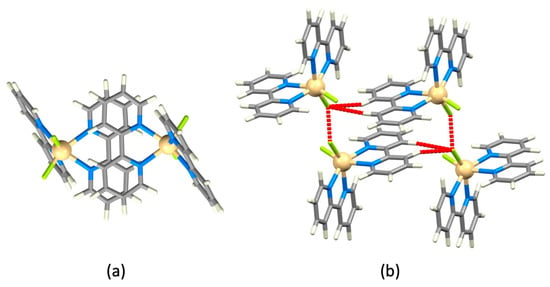
Figure 11.
(a) One of two crystallographically independent centrosymmetric bpy...bpy π-stacking motifs in cis-[Cd(bpy)2F2]·3.5H2O (CSD refcode YAYMET) [6]. (b) The bpy H3 and H3′ atoms in the motif shown in (a) form CH...F interactions with adjacent molecules; H...F and F...F contacts are shown in red. In the second crystallographically independent motif of this type, only one H...F distance is short enough to be considered (see Table 7).

Of the 21 solvated cis-[M(bpy)2X2] compounds, only three fail to exhibit a dimeric motif supported by intermolecular CHbpy...X and bpy...bpy π-stacking interactions. These are cis-[Os(bpy)2Cl2]·CH2Cl2 (CSD refcode UKOHOT [51]), cis-[Fe(bpy)2Cl2]·MeCO2Me (CSD refcode HAJGAB [52]), and cis-[Ni(bpy)2Cl2]·2DMF (CSD refcode PORKIQ, PORKIQ01 [53]). The latter two compounds are structurally similar and comprise heterochiral layers separated by sheets of methyl acetate or DMF molecules.
6. Conclusions
Following from our observations of dominant crystal-packing motifs in the solid-state structures of [M(bpy)3]q+ salts containing halide, [XY3]m− or [XY4]m− anions [2,3], we now draw attention to persistent supramolecular motifs in the solid-state structures of [M(bpy)2X2] complexes with M = any metal and X = F, Cl, Br, and I. The crystal structures of non-solvated cis-[M(bpy)2X2] compounds exhibit a ubiquitous motif supported by CHbpy...X (X = Cl, Br, I) interactions (CHbpy = H3, H4 or H5) and a bpy...bpy π-stacking interaction. For the dominant group of compounds that crystallize in the monoclinic space group P21/c, the data in Table 2 illustrate that longer M–X bonds lead to less efficient π-stacking contact, and alternative packing arrangements emerge that mostly retain a π-stacked motif supported by H3/4/5...X interactions. In solvated cis-[M(bpy)2X2] compounds, the dimeric motif supported by intermolecular CHbpy...X and bpy...bpy π-stacking interactions is again prevalent. The only fluorido complex in the cis-[M(bpy)2X2 family is cis-[Cd(bpy)2F2]·3.5H2O and this also exhibits dimeric bpy...bpy π-stacked units; however, CHbpy...F contacts involve additional molecules.
The identification of the dimeric motif supported by CHbpy...X and bpy...bpy π-stacking interactions and associated with some of the commonest ligands (halides and oligopyridines) potentially adds an additional and valuable tool to the arsenal available for designed crystal engineering.
Author Contributions
The authors contributed equally to the writing of this work. Conceptualization: E.C.C. and C.E.H. Data mining and evaluation: E.C.C. and C.E.H. All authors have read and agreed to the published version of the manuscript.
Funding
This research received no external funding.
Data Availability Statement
Not applicable.
Acknowledgments
We thank the University of Basel for support.
Conflicts of Interest
The authors declare no conflict of interest.
Sample Availability
Not applicable.
References
- Groom, C.R.; Bruno, I.J.; Lightfoot, M.P.; Ward, S.C. The Cambridge Structural Database. Acta Crystallogr. Sect. B Struct. Sci. Cryst. Eng. Mater. 2016, B72, 171–179. [Google Scholar] [CrossRef]
- Constable, E.C.; Housecroft, C.E. Halide Ion Embraces in Tris(2,2′-bipyridine)metal Complexes. Crystals 2020, 10, 671. [Google Scholar] [CrossRef]
- Constable, E.C.; Housecroft, C.E. Embracing [XY3]m− and [XY4]m− anions in salts of [M(bpy)3]q+. Crystals 2023, 13, 97. [Google Scholar] [CrossRef]
- Eggleston, D.S.; Goldsby, K.A.; Hodgson, D.J.; Meyer, T.J. Structural Variations Induced by Changes in Oxidation State and Their Role in Electron Transfer. Crystal and Molecular Structures of cis-[Ru(bpy)2Cl2]·3.5H2O and cis-[Ru(bpy)2Cl2]Cl·2H2O. Inorg. Chem. 1985, 24, 4573–4584. [Google Scholar] [CrossRef]
- McCann, S.; McCann, M.; Casey, M.T.; Jackman, M.; Devereux, M.; McKee, V. Syntheses and X-ray crystal structures of cis-[Mn(bipy)2Cl2]·2H2O·EtOH and cis-[Mn(phen)2Cl2] (bipy = 2,2′-bipyridine; phen = 1,10-phenanthroline); catalysts for the disproportionation of hydrogen peroxide. Inorg. Chim. Acta 1998, 279, 24–29. [Google Scholar] [CrossRef]
- Swiatkowski, M.; Kruszynski, R. Revealing the structural chemistry of the group 12 halide coordination compounds with 2,2′-bipyridine and 1,10-phenanthroline. J. Coord. Chem. 2017, 70, 642–675. [Google Scholar] [CrossRef]
- Toyama, M. Crystal Structure of cis-Bis(2,2′-bipyridine)dichlorocobalt(III) Nitrate Methanol Solvate. X-ray Struct. Anal. Online 2018, 34, 41–43. [Google Scholar] [CrossRef]
- Hwang, I.-C.; Ha, K. Crystal structure of bis(2,2′-bipyridine-N,N′)dibromomanganese(II), MnBr2(C10H8N2)2. Z. Kristallogr. New Cryst. Struct. 2007, 222, 209–210. [Google Scholar] [CrossRef]
- Kavitha, S.J.; Panchanatheswaran, K.; Low, J.N.; Glidewell, C. Racemic cis-bis(2,2′-bipyridyl)difluorovanadium(III) tetrafluoroborate. Acta Crystallogr. Sect. E Struct. Rep. Online 2005, E61, m1965–m1967. [Google Scholar] [CrossRef]
- Yamaguchi-Terasaki, Y.; Fujihara, T.; Nagasawa, A.; Kaizaki, S. cis-Bis(2,2′-bipyridine)difluorochromium(III) perchlorate. Acta Crystallogr. Sect. E Struct. Rep. Online 2007, E63, m593–m595. [Google Scholar] [CrossRef]
- Li, Z.; Xu, D.; Nie, J.; Wu, Z.; Wu, J.; Chiang, M.Y. Synthesis and Crystal Structure of Bis(2,2′-Bipyridine-N,N′)Dichloromanganese(II) Complex with Free 2,2′-Bipyridine. J. Coord. Chem. 2002, 55, 1155–1160. [Google Scholar] [CrossRef]
- Choudhury, S.R.; Dutta, A.; Mukhopadhyay, S.; Lu, L.-P.; Zhu, M.-L. cis-(2,2′-Bipyridyl)dichloromanganese(II)–thiourea (1/1). Acta Crystallogr. Sect. E Struct. Rep. Online 2006, E62, m1489–m1491. [Google Scholar] [CrossRef]
- Ferbinteanu, M.; Cimpoesu, F.; Andruh, M.; Rochon, F.D. Solid-state chemistry of [Ni(AA)3][PdCl4]·nH2O complexes (AA = bipy, phen) and crystal structures of cis-diaqua-bis(phenanthroline)nickel(II) tetrachlorozincate and cis-dichlorobis(bipyridine)nickel(II). Polyhedron 1998, 17, 3671–3679. [Google Scholar] [CrossRef]
- Ha, K. A second monoclinic polymorph of bis(2,2′-bipyridine-κ2N,N′)diiodidomanganese(II). Acta Crystallogr. Sect. E Struct. Rep. Online 2011, E67, m1351. [Google Scholar] [CrossRef]
- Kim, N.-H.; Hwang, I.-C.; Ha, K. Bis(2,2′-bipyridine-κ2N,N′)dichloridoplatinum(IV) dichloride monohydrate. Acta Crystallogr. Sect. E Struct. Rep. Online 2009, E65, m180. [Google Scholar] [CrossRef]
- Lumme, P.O.; Lindell, E. Structure of cis-Bis(2,2′-bipyridine-N,N′)dichloromanganese(II). Acta Crystallogr. Sect. C Cryst. Struct. Commun. 1988, C44, 463–465. [Google Scholar] [CrossRef]
- Prajapati, R.; Yadav, V.K.; Dubey, S.K.; Durham, B.; Mishra, L. Reactivity of metal (ZnII, RuII)-2,2′-bipyridyl with some bifunctional ligands. Ind. J. Chem. 2008, 47A, 1780–1786. [Google Scholar]
- Čechová, D.; Martišková, A.; Moncol, J. Structure of cis-dichlorobis(1,10-phenanthroline)manganese(II) and cis-dichlorobis(2,2′-bipyridine)manganese(II). Acta Chim. Slovaca 2014, 7, 15–19. [Google Scholar] [CrossRef]
- Fischer, E.; Hummel, H.-U. Untersuchungen im quasi-binären System LiI/2,2′-Bipyridin. Z. Anorg. Allg. Chem. 1997, 623, 483–486. [Google Scholar] [CrossRef]
- Wojciechowska, A.; Bronowska, W.; Pietraszko, A.; Staszak, Z.; Cieślak-Golonka, M. Synthesis, crystal structure and spectroscopic characterisation of double salt [Zn(bpy)3](CrO4)0.5NO3·6.5H2O. J. Mol. Struct. 2002, 608, 151–160. [Google Scholar] [CrossRef]
- Chesnut, D.J.; Haushalter, R.C.; Zubieta, J. The hydrothermal synthesis and structural characterization of a new class of compounds: Nickel organoamine-halocadmates. Inorg. Chim. Acta 1999, 292, 41–51. [Google Scholar] [CrossRef]
- Bruno, I.J.; Cole, J.C.; Edgington, P.R.; Kessler, M.; Macrae, C.F.; McCabe, P.; Pearson, J.; Taylor, R. New software for searching the Cambridge Structural Database and visualising crystal structures. Acta Crystallogr. Sect. B Struct. Crystallogr. Cryst. Chem. 2002, B58, 389–397. [Google Scholar] [CrossRef] [PubMed]
- Macrae, C.F.; Sovago, I.; Cottrell, S.J.; Galek, P.T.A.; McCabe, P.; Pidcock, E.; Platings, M.; Shields, G.P.; Stevens, J.S.; Towler, M.; et al. Mercury 4.0: From visualization to analysis, design and prediction. J. Appl. Crystallogr. 2020, 53, 226–235. [Google Scholar] [CrossRef] [PubMed]
- Miloserdov, F.M.; Kirillova, M.S.; Muratore, M.E.; Echavarren, A.M. Unified Total Synthesis of Pyrroloazocine Indole Alkaloids Sheds Light on Their Biosynthetic Relationship. J. Am. Chem. Soc. 2018, 140, 5393–5400. [Google Scholar] [CrossRef] [PubMed]
- Janiak, C. A critical account on π–π stacking in metal complexes with aromatic nitrogen-containing ligands. J. Chem. Soc. Dalton Trans. 2000, 3885–3896. [Google Scholar] [CrossRef]
- Ha, K. Crystal structure of bis(2,2′-bipyridine-N,N′)diiodomanganese(II), MnI2(C10H8N2)2. Z. Kristallogr. New Cryst. Struct. 2011, 226, 187–188. [Google Scholar] [CrossRef]
- Park, H.-M.; Hwang, I.-H.; Bae, J.-M.; Jo, Y.-D.; Kim, C.; Kim, H.-Y.; Kim, Y.-M.; Kim, S.-J. Anion Effects on Crystal Structures of CdII Complexes Containing 2,2′-Bipyridine: Photoluminescence and Catalytic Reactivity. Bull. Korean Chem. Soc. 2012, 33, 1517–1522. [Google Scholar] [CrossRef]
- Skelton, B.W.; Waters, A.F.; White, A.H. Synthesis and Structural Systematics of Nitrogen Base Adducts of Group 2 Salts. VII: Some Complexes of Group 2 Metal Halides with Aromatic N,N′-Bidentate Ligands. Aust. J. Chem. 1996, 49, 99–115. [Google Scholar] [CrossRef]
- Ruiz, A.C.; Damodaran, K.K.; Suman, S.G. Towards a selective synthetic route for cobalt amino acid complexes and their application in ring opening polymerization of rac-lactide. RSC Adv. 2021, 11, 16326–16338. [Google Scholar] [CrossRef]
- Gao, S.; Ng, S.W. Bis(2,2′-bipyridine-κ2N,N′)dichloridocadmium(II). Acta Crystallogr. Sect. E Struct. Rep. Online 2010, E66, m1692. [Google Scholar] [CrossRef]
- Zhang, B.-S. Bis(2,2′-bipyridine-κ2N,N′)dibromidocadmium(II). Acta Crystallogr. Sect. E Struct. Rep. Online 2009, E65, m1413. [Google Scholar] [CrossRef] [PubMed]
- Shirley, H.; Parkin, S.; Delcamp, J.H. Photoinduced Generation of a Durable Thermal Proton Reduction Catalyst with in Situ Conversion of Mn(bpy)(CO)3Br to Mn(bpy)2Br2. Inorg. Chem. 2020, 59, 11266–11272. [Google Scholar] [CrossRef] [PubMed]
- Yang, E.-L.; Zhang, N.; Shan, Z.-M.; Wang, Y.-L.; Hu, H.-C.; Liu, Q.-Y. Ionothermal Syntheses and Crystal Structures of Two Cobalt(II) Compounds: Co(2,2′-bpy)2Br2 and Co(1,10-phen)2Br2. Chin. J. Struct. Chem. 2011, 30, 196–201. [Google Scholar]
- Dorval, C.; Tricoire, M.; Begouin, J.-M.; Gandon, V.; Gosmini, C. Cobalt-Catalyzed C(sp2)–CN Bond Activation: Cross-Electrophile Coupling for Biaryl Formation and Mechanistic Insight. ACS Catal. 2020, 10, 12819–12827. [Google Scholar] [CrossRef]
- Guo, H.-X.; Lin, H.-B.; Wang, Q.-H. cis-Bis(2,2′-bipyridine)diiodocadmium(II). Acta Crystallogr. Sect. E Struct. Rep. Online 2006, E62, m1239–m1240. [Google Scholar] [CrossRef]
- Nishio, M. CH/π hydrogen bonds in crystals. CrystEngComm 2004, 6, 130–158. [Google Scholar] [CrossRef]
- Ha, K. Crystal structure of cis-bis(2,2′-bipyridine-κ2N,N′)dibromidomanganese(II), C20H16Br2MnN4. Z. Kristallogr. New Cryst. Struct. 2017, 232, 149–150. [Google Scholar] [CrossRef]
- Zhu, J.-W.; Yang, E.; Song, X.-C.; Lin, Y.-D. Bis(2,2′-bipyridine-κ2N,N′)dibromidocadmium(II). Acta Crystallogr. Sect. E Struct. Rep. Online 2007, E63, m1044–m1045. [Google Scholar] [CrossRef]
- Muley, A.; Karumban, K.S.; Kumbhakar, S.; Giri, B.; Maji, S. High phenoxazinone synthase activity of two mononuclear cis-dichlorocobalt(II) complexes with a rigid pyridyl scaffold. New J. Chem. 2021, 46, 521–532. [Google Scholar] [CrossRef]
- Kumar, K.A.; Amuthaselvi, M.; Dayalan, A. cis-Bis(2,2′-bipyridine-κ2N,N′)dichloridocobalt(II) trihydrate. Acta Crystallogr. Sect. E Struct. Rep. Online 2011, E67, m468. [Google Scholar] [CrossRef]
- Blasberg, F.; Bolte, M.; Wagner, M. CCDC 2158871: Experimental Crystal Structure Determination; CCDC: Cambridge, UK, 2022. [Google Scholar] [CrossRef]
- Nag, S.; Drew, M.G.B.; Datta, D. Intercalation of diiodine molecules in cis-Ru(bpy)2Cl2. Inorg. Chem. Commun. 2006, 9, 310–312. [Google Scholar] [CrossRef]
- Kramer, T.; Strahle, J. Synthese, Eigenschaften und Struktur von Bipyridin-Halogeno-Komplexen des Cobalts. Z. Naturforsch. 1986, B41, 692–696. [Google Scholar] [CrossRef]
- Dudkina, Y.B.; Fayzullin, R.R.; Lyssenko, K.A.; Gubaidullin, A.T.; Kholin, K.V.; Levitskaya, A.I.; Balakina, M.Y.; Budnikova, Y.H. Cyclometalated Nickel Complexes as Key Intermediates in C(sp2)–H Bond Functionalization: Synthesis, Catalysis, Electrochemical Properties, and DFT Calculations. Organometallics 2018, 38, 1254–1263. [Google Scholar] [CrossRef]
- Blasberg, F.; Bolte, M. CCDC 795576: Experimental Crystal Structure Determination; CCDC: Cambridge, UK, 2010. [Google Scholar] [CrossRef]
- Florke, U.; Ortmeyer, J. CCDC 1587638: Experimental Crystal Structure Determination; CCDC: Cambridge, UK, 2017. [Google Scholar] [CrossRef]
- Florke, U. CCDC 1581275: Experimental Crystal Structure Determination; CCDC: Cambridge, UK, 2017. [Google Scholar] [CrossRef]
- Fontaine, F.G. cis-Bis(2,2-bipyridine)dichloronickel(II) methanol solvate. Acta Crystallogr. Sect. E Struct. Rep. Online 2001, E51, m270–m271. [Google Scholar] [CrossRef]
- Yu, M.; Wang, Y.; Hu, J.-M. Synthesis, Crystal Structure and Spectroscopy Studies on Complex cis-OsII(bpy)2Cl2 and Its Oxidation Product [cis-OsIII(bpy)2Cl2](PF6). Chin. J. Struct. Chem. 2018, 37, 995–1003. [Google Scholar] [CrossRef]
- Al-Noaimi, M.; Haddad, S.F. cis-Bis(2,2′-bipyridyl)dichloridoruthenium(II) dichloromethane solvate. Acta Crystallogr. Sect. E Struct. Rep. Online 2007, E63, m2332. [Google Scholar] [CrossRef]
- Groppi, J.; Bartlett, P.N.; Kilburn, J.D. Toward the Control of the Creation of Mixed Monolayers on Glassy Carbon Surfaces by Amine Oxidation. Chem. Eur. J. 2016, 22, 1030–1036. [Google Scholar] [CrossRef]
- Parsons, S.; Winpenny, R.; Wood, P.A. CCDC 248214: Experimental Crystal Structure Determination; CCDC: Cambridge, UK, 2004. [Google Scholar] [CrossRef]
- Hipler, B.; Doring, M.; Dubs, C.; Görls, H.; Hübler, T.; Uhlig, E. Bildung und Strukturen von Nickelacyclen des Typs (LL′) NiCH2CH2C(O)O. Z. Anorg. Allg. Chem. 1998, 624, 1329–1335. [Google Scholar] [CrossRef]
Disclaimer/Publisher’s Note: The statements, opinions and data contained in all publications are solely those of the individual author(s) and contributor(s) and not of MDPI and/or the editor(s). MDPI and/or the editor(s) disclaim responsibility for any injury to people or property resulting from any ideas, methods, instructions or products referred to in the content. |
© 2023 by the authors. Licensee MDPI, Basel, Switzerland. This article is an open access article distributed under the terms and conditions of the Creative Commons Attribution (CC BY) license (https://creativecommons.org/licenses/by/4.0/).